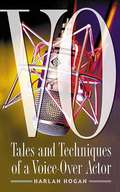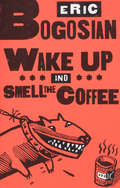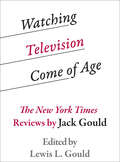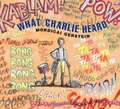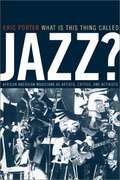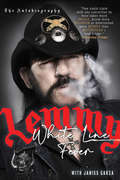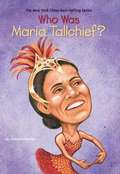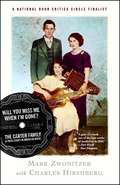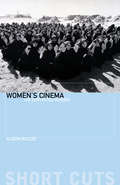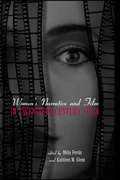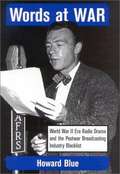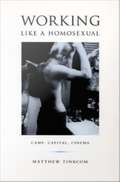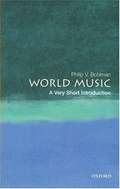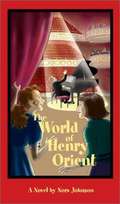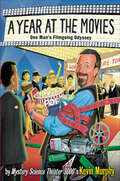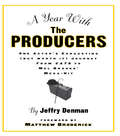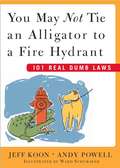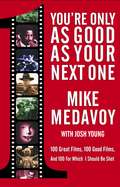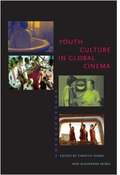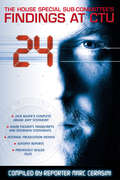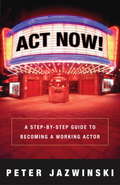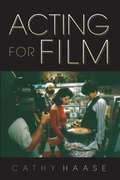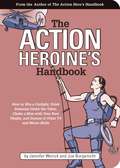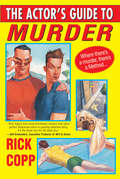- Table View
- List View
VO: Tales and Techniques of a Voice-over Actor
by Harlan HoganNot only does veteran actor Harlan Hogan offer a fascinating personal account of the crazed clients, practical jokes, and amazing coincidences encountered during his twenty-five year career, he also provides a wealth of tested tips for surviving and thriving as a voice-over actor.This indispensable guide features dozens of techniques to help readers train their voices, gain experience, make a demo, join unions, get an agent, and more. It also includes strategies for finding work in venues outside film and television, including games, automated telephone systems, and even Web sites. Actors, broadcasters, and anyone else who longs to make money speaking into a microphone will cherish this informative, insightful, and often hilarious glimpse at the business.
Wake Up and Smell the Coffee
by Eric Bogosian100% pure high octane Bogosian.Bogosian's latest and greatest monologue."His wit is as venomous as ever, his material even more devastating and polished than before."--New York Daily News"Bogosian hasn't simply crossed the line of good taste, he has snorted it."--The Daily TexanWake Up is Bogosian's meditation on making it to the top of the ladder, on falling off the ladder and on the exhilarating thrill of the ultimate crash and burn. Once again the author offers a blisteringly funny and dead-on take of the chaos and alienation of post-modern life in the U. S. of the year 2000. As Michael Feingold so ably offered in his Village Voice review--"Bogosian is there, watching out for the downtrodden, ridiculing the arrogant rich, defending battered wives and neo-hippie hitchhikers and never losing sight of his own capacity for being classed among the batters and bullies. But his 95 minutes is as fast and exciting a read as the theatre community offers. In our time, the stage has almost been what classical thinkers saw it as, a medium for criticizing life. How perfect that a solo performer should rediscover its roots, by choosing his own life as the object of his criticism."Eric Bogosian, born in Woburn, Massachusetts, has performed his plays and monologues at venues nationwide. Winner of Obie and Drama Desk Awards, he has made four films of his work, most notably Talk Radio and Suburbia. His novel Mall was recently published by Simon and Schuster.
Watching Television Come of Age: The New York Times Reviews by Jack Gould (Focus on American History Series)
by Lewis L. GouldProviding video companionship for isolated housewives, afternoon babysitting for children, and nonstop evening entertainment for the whole family, television revolutionized American society in the post-World War II years. Helping the first TV generation make sense of the new medium was the mission of Jack Gould, television critic of The New York Times from 1947 to 1972. In columns noteworthy for crisp writing, pointed insights, and fair judgment, he highlighted both the untapped possibilities and the imminent perils of television, becoming "the conscience of the industry" for many people.
What Charlie Heard
by Mordicai GersteinDescribes the life of American composer Charles Ives, who wrote music which expressed all the sounds he heard in the world, but which was not well received during his lifetime.
What Is This Thing Called Jazz? African American Musicians as Artists, Critics, and Activists
by Eric PorterWhat Is This Thing Called Jazz? challenges interpretive orthodoxies by showing how much black jazz musicians have struggled against both the racism of the dominant culture and the prescriptive definitions of racial authenticity propagated by the music's supporters, both white and black.
White Line Fever: The Autobiography
by Lemmy Garza Janiss KilmisterOne of music's most notorious frontmen leads a headbanging, voyeuristic odyssey into sex, drugs, and rock 'n' roll that rivals Motley Crue's The Dirt and Aerosmith's Walk This Way. <P><P>He made Keith Richards look like a choirboy and Mick Jagger look like a nun. And as the head of the legendary band Motorhead, he ploughed his way through so many drugs, so many women, and so much alcohol, that he gave a whole new meaning to the term Debauchery. And he changed the face of music, conquering the rock world with such songs as Ace of Spades, Bomber, and Overkill and inventing a whole new form of music--speed metal. At the age of 57, Lemmy Kilmister remains a rock icon, both for his monumental talent and his hedonistic lifestyle. In White Line Fever, he recounts his incredible, pleasure-filled, and death-defying journey through music history. Born on Christmas Eve, 1945, in Wales, to a vicar and a librarian, Ian Fraser Kilmister learned early, he as he forthrightly puts it, what an incredible pussy magnet guitars were. A teenager at the birth of rock 'n' roll, Lemmy idolized Elvis and Buddy Holly and soon joined a band of his own. He would eventually head to London, where he became a roadie for Jimi Hendrix, played in Opal Butterfly, and joined space rockers Hawkwind's lineup in 1971. Four years later, speedfreak Lemmy was fired from the band for doing the wrong drugs. Vowing to form the dirtiest rock 'n' roll band in the world, he formed Motorhead, arguably the heaviest and loudest heavy metal band to ever take the stage. During their twenty-seven-year history, Motorhead would go on to release twenty-one albums, including the #1 record No Sleep 'Til Hammersmith and would earn a Grammynomination. Lemmy would also cheat death on more than one occasion, most notoriously in 1980, when his doctor told him, I cannot give you a blood transfusion because normal blood will kill you. . . and your blood would kill another human being, because you're so toxic. But through more than two decades of notorious excess, Lemmy has lived to tell the warts-and-all tale of a life lived over the edge. White Line Fever, a tour of overindulgence, metal, and the search for musical integrity, offers a sometimes hilarious, often outrageous, and always unbridled ride with the leader of the loudest rock band in the world. "
Who Is Maria Tallchief?
by Catherine GourleyBorn in 1925, Maria Tallchief spent part of her childhood on an Osage reservation in Oklahoma. With the support of her family and world-renowned choreographer George Balanchine, she rose to the top of her art form to become America's first prima ballerina.
Will You Miss Me When I'm Gone?
by Mark Zwonitzer Charles HirshbergWill You Miss Me When I'm Gone? is the first major biography of the Carter Family, the musical pioneers who almost single-handedly established the sounds and traditions that grew into modern folk, country, and bluegrass music -- a style celebrated in O Brother, Where Art Thou?A.P. Carter was a restless man, seemingly in a constant state of motion. On one of his travels across the sparsely settled mountains and valleys that surrounded his home in southern Virginia, he met and married a young girl named Sara Dougherty. Orphaned as a child, Sara was remote by nature but seemed to find release in singing the typically melancholy ballads that were a part of her home tradition.For fun, A.P., Sara, and her cousin Maybelle (who married A.P.'s brother "Eck" Carter) would play and sing the hymns and ballads known in their Poor Valley community, occasionally adding songs A.P. had collected during his travels. Then, in 1927, they traveled to Bristol, Tennessee, to audition for a New York record executive who was hunting "hillbilly" talent and offering an amazing fifty dollars per song for any he recorded. These Bristol recording sessions would become generally accepted as the "Big Bang" of country music, producing two of its first stars: Jimmie Rodgers and the Carter Family.By the early 1930s, the Carter Family was the most bankable country music group in America, with total sales of more than a million records. By the late '30s, they were appearing regularly on high-power radio station XERA, which broadcast from coast to coast. A whole generation of country people could gather around the radio and hear the sound of music that came straight from their world. Johnny Cash in Arkansas, Waylon Jennings in Texas, Chet Atkins in Georgia, and Tom T. Hall in Kentucky all listened to the Carter Family. It was their formal schooling, Country Music 101.Inside the Carter Family, however, things were hardly perfect. Though nobody outside the family knew it, Sara had left her difficult and quixotic husband in 1933. In 1936 she won a divorce. Even throughout the long and painful breakup, the Carters kept performing together, singing an ever-widening range of new songs they wrote or old songs they remade: songs of love, of betrayal, and of the death of fondest hopes. And they kept at it even after Sara married A.P.'s cousin Coy Bays in 1939. After fulfilling a final radio contract in 1943, Sara and Coy moved to California to settle near his family. The original Carter Family never performed or recorded together again.With Sara gone, A.P. retreated home, opened a general store, and lived out the next two decades in obscurity, the odd man out in a new and reconfigured Carter musical clan. Meanwhile, Maybelle and her daughters (Helen, June, and Anita) went out and got themselves new radio contracts, working in Richmond, Virginia; Knoxville, Tennessee; and Springfield, Missouri, before ascending to country music's ultimate stage, Nashville's Grand Ole Opry. Nearly fifty years in the business won Maybelle the title "Mother of Country Music" and the adoration of generations of guitar players and just plain listeners.The story of the Carter Family is a bittersweet saga of love and fulfillment, sadness and loss. Will You Miss Me When I'm Gone? is more than just a biography of a family; it is also a journey into another time, almost another world. But their story resonates today and lives on in the timeless music they created.
Will You Miss Me When I'm Gone: The Carter Family and their Legacy in American Music
by Mark Zwonitzer Charles HirshbergWomen's Cinema: The Contested Screen (Short Cuts)
by Alison ButlerWomen's Cinema provides an introduction to critical debates around women's filmmaking and relates those debates to a variety of cinematic practices. Taking her cue from the groundbreaking theories of Claire Johnston, Alison Butler argues that women's cinema is a minor cinema that exists inside other cinemas, inflecting and contesting the codes and systems of the major cinematic traditions from within. Using canonical directors and less established names, ranging from Chantal Akerman to Moufida Tlatli, as examples, Butler argues that women's cinema is unified in spite of its diversity by the ways in which it reworks cinematic conventions.
Women's Narrative and Film in 20th Century Spain
by Kathleen GlennWomen's Narrative and Film in 20th Century Spain examines the development of the feminine cultural tradition in spain and how this tradition reshaped and defined a Spanish national identity. Each chapter focuses on representation of autobiography, alienation and exile, marginality, race, eroticism, political activism, and feminism within the ever-changing nationalisms in different regions of Spain. The book describes how concepts of gender and difference shaped the individual, collective, and national identities of Spanish women and significantly modified the meaning and representation of female sexuality.
Words at War: World War II Era Radio Drama and the Postwar Broadcasting Industry Blacklist
by Howard BlueThe history of radio broadcasting in the US, with an emphasis on World War II and the blacklisting during the 1950s.
Working Like a Homosexual: Camp, Capital, Cinema
by Matthew TinkcomWhat does camp have to do with capitalism? How have queer men created a philosophy of commodity culture? Why is cinema central to camp? With chapters on the films of Vincente Minnelli, Andy Warhol, Kenneth Anger, and John Waters, Working Like a Homosexual responds to these questions by arguing that post-World War II gay male subcultures have fostered their own ways not only of consuming mass culture but of producing it as well. With a special emphasis on the tensions between high and low forms of culture and between good and bad taste, Matthew Tinkcom offers a new vision of queer politics and aesthetics that is critically engaged with Marxist theories of capitalist production. He argues that camp--while embracing the cheap, the scorned, the gaudy, the tasteless, and what Warhol called "the leftovers" of artistic production--is a mode of intellectual production and a critical philosophy of modernity as much as it is an expression of a dissident sex/gender difference. From Minnelli's musicals and the "everyday glamour" of Warhol's films to Anger's experimental films and Waters's "trash aesthetic," Tinkcom demonstrates how camp allowed these gay men to design their own relationship to labor and to history in a way that protected them from censure even as they struggled to forge a role for themselves within a system of "value" that failed to recognize them.
World Music: A Very Short Introduction
by Philip V. BohlmanWorld Music draws readers into a remarkable range of historical encounters, in which music had the power to evoke the exotic and to give voice to the voiceless. In the course of the volume's eight chapters the reader witnesses music's involvement in the modern world, but also the individual moments and particular histories that are crucial to an understanding of music's diversity. This book is wide-ranging in its geographical scope, yet individual chapters provide in-depth treatments of selected music cultures and regional music histories. The book frequently zooms in on repertoires and musicians--such as Bob Marley, Dana International, Bartok, and Nusrat Fateh Ali Khan--and attempts to account for world music's growing presence and popularity at the beginning of the twenty-first century.
The World of Henry Orient
by Nora Johnson"Two adolescent girls find companionship in each other as they follow the life of a concert pianist."
A Year at the Movies: One Man's Filmgoing Odyssey
by Kevin MurphyFor some of us, moviegoing is an occasional pleasure. Kevin Murphy made it his obsession, and he did it for you.Mr. Murphy, known to legions of fans as Tom Servo on the legendary TV series Mystery Science Theater 3000, went to the movies every day for a year. That's every single day, people. For a whole fricken' year. And not only did he endure, he prevailed -- for this is the hilarious, poignant, fascinating journal of his adventures: the first book about the movies from the audience's point of view.Kevin went to the multiplex, sure. But he didn't stop there. He found the world's smallest commercial movie theater. Another one made completely of ice. Checked out flicks in a tin-roofed hut in the South Pacific. Tooled across the desert from drive-in to drive-in in a groovy convertible. Lived for a week solely on theater food. Took six different women to the same date movie. Dressed up as a nun for the Sing-Along Sound of Music in London. Sneaked into the Cannes and Sundance film festivals. Smuggled an entire Thanksgiving dinner into a movie theater. And saw hundreds of films, from the Arctic Circle to the Equator, from the sublime to the unspeakable. Come along on a joyous global celebration of the cinema with a man on a mission -- to spend A Year at the Movies.
A Year with the Producers: One Actor's Exhausting (But Worth It) Journey from Cats to Mel Brooks' Mega-Hit (A\theatre Arts Book Ser.)
by Jeffry DenmanA behind-the-scenes story with more than a touch of theatrical magic about it, A Year with The Producers is a book for actors and theater fans everywhere.
You May Not Tie an Alligator to a Fire Hydrant: 101 Real Dumb Laws
by Jeff Koon Andy PowellThis hilarious collection of 101 bizarre state laws from across the USA is by the teenage creators of the successful website, DumbLaws.com.
You're Only as Good as Your Next One
by Mike Medavoy Josh Young"If I had a talent for anything, it was a talent for knowing who was talented."Mike Medavoy is a Hollywood rarity: a studio executive who, though never far from controversy, has remained well loved and respected through four decades of moviemaking. What further sets him apart is his role in bringing to the screen some of the most acclaimed Oscar-winning films of our time: Apocalypse Now, One Flew Over the Cuckoo's Nest, Amadeus, The Silence of the Lambs, Philadelphia, and Sleepless in Seattle are just some of the projects he green-lighted at United Artists, Orion, TriStar, his own Phoenix Pictures."The ultimate lose-lose situation for a studio executive: to wind up with a commercial bomb and a bad movie."Of course, there are the box office disasters, and the films, as Medavoy says, "for which I should be shot." They, too, have a place in his fascinating memoir -- a pull-no-punches account of financial and political maneuvering, and of working with the industry's brightest star power, including Steven Spielberg, Martin Scorsese, Francis Ford Coppola, Kevin Costner, Robert De Niro, Jodie Foster, Sharon Stone, Michael Douglas, Meg Ryan, and countless others."Putting together the elements of a film is a succession of best guesses."Medavoy speaks out on how movie studio buyouts have stymied the creative process and brought an end to the "hands-off" golden age of filmmaking. An eyewitness to Hollywood history in the making, he gives a powerful and poignant view of the past and future of a world he knows intimately.
Youth Culture in Global Cinema
by Timothy Shary Alexandra SeibelComing of age is a pivotal experience for everyone. So it is no surprise that filmmakers around the globe explore the experiences of growing up in their work. From blockbuster U.S. movies such as the Harry Potter series to thought-provoking foreign films such as Bend It Like Beckham and Whale Rider, films about youth delve into young people's attitudes, styles, sexuality, race, families, cultures, class, psychology, and ideas. These cinematic representations of youth also reflect perceptions about youth in their respective cultures, as well as young people's worth to the larger society. Indeed, as the contributors to this volume make plain, films about young people open a very revealing window on the attitudes and values of cultures across the globe.
24: The House Special Subcommittee's Findings at CTU
by Marc CerasiniLast season, CIA agent Jack Bauer, played by Golden Globe award-winning actor Keifer Sutherland, had us glued to our TVs and cursing the time clock as he uncovered a plot to assassinate presidential nominee, David Palmer. With just 24 hours to identify the killer, Bauer also had to deal with the kidnapping of his wife and daughter and the existence of a mole at the agency. This season he's at it again, helping President David Palmer save Los Angeles from nuclear ravage. Lest you think Jack had some down time between life-altering experiences, check out 24: The House Special Subcommittees Findings at CTU. It's a new book providing a riveting account of Jack's grueling appearance before our government's most inquiring minds during their probe into alleged wrongdoings at CTU that first fateful 24 hour period. The testimony from these closed hearings was leaked to investigative journalist Marc Cerasini, who then ran with it to publisher HarperCollins. With some of the finest reporting seen since Woodward's coverage of the Pentagon Papers, this book contains: Jack Bauer's complete Grand Jury Testimony Press statements from President-elect David Palmer Transcribed debriefings with other key CTU agents Previously sealed files on Bauer's related undercover act6ivities The arrest, detainment and transport records for Victor Drazen Teri Bauer's medical records Autopsy reports Campaign finance records Commentary from the Beltway's most celebrated political pundits Theories as to how and why key players within CTU turned.
Act Now! A Step-by-step Guide to Becoming a Working Actor
by Peter JazwinskiSo, you want to be an actor . . . but you have no idea how to get started. In the pages of Act Now!, you'll find a step-by-step process to show you not only how to get started, but also how to become a working actor. It will take time and commitment, but if you follow these steps you will find success. Author and acting teacher Peter Jazwinski explains every aspect of becoming an actor from start to finish. You'll learn about: * Improving Your Acting Skills * How Actors Get Cast * Finding Auditions on Your Own * Working with an Agent or Manager--and What the Difference Is * The Importance of Networking * And More! A frank and encouraging game plan for success,Act Now!will empower those who have the drive to stop dreaming and start making a living--as an actor.
Acting for Film
by Cathy HaaseAspiring film and television actors will discover exercises for relaxing the face to achieve maximum expressiveness; maintaining proper eye focus in front of the camera and conveying the "beats" of a scene, even in the shortest takes. They'll also learn tested techniques for adapting to the styles of different directors; modulating voice and breath for maximum effect; preparing for the first day on the set; enduring multiple takes and on-the-set waiting; and much, much more. For any performer who intends to make a living in front of the camera, Acting for Film is the most authoritative resource!
The Action Heroine's Handbook: How to Win a Catfight, Drink Someone Under the Table, Choke a Man with Your Bare Thighs, and Dozens of Other TV and Movie Skills
by Joe Borgenicht Jennifer WorickGet Some Action! For every woman who wants to be as tough as Lara Croft, as nimble as the Bionic Woman, and as babe-a-licious as Charlie's Angels, The Action Heroine's Handbook shows you the essential skills you'll need to conquer the bad guys and save the day without breaking a sweat. Find out how the real action heroines do it, directly from a host of experts, including stuntwomen, jujitsu instructors, helicopter pilots, detectives, forensic psychologists, survivalists, primatologists, and many others. Learn to: * Profile a serial killer * Outwit a band of home intruders * Navigate white water rapids * Go undercover as a beauty queen * Outrun a fireball, and dozens of other Tough Chick Skills, Beauty Skills, Brain Skills, Brawn Skills, and Escape Skills. Special sections and appendices feature the top action heroine hairdos, handbag essentials, and the best footwear for every action situation. With step-by-step instructions and easy-to-follow illustrations, The Action Heroine's Handbook will prepare you to save the world, one baddie at a time.
The Actor's Guide To Murder
by Rick Copp"Baby, don't even go there!" That was Jarrod Jarvis's catch phrase as the adorable, girl-crazy moppet on the eighties sitcom, Go To Your Room! It was a great ride until the tabloids caught the popular teen idol kissing another guy at the L. A. gay rodeo. "Gay" and "teen heartthrob" not exactly being career-making words at the time, Jarrod's star crashed harder than a Kathie Lee Gifford CD. Flash forward: Now happily living with his cop boyfriend, Charlie, and their dog, Snickers, in the Hollywood Hills, Jarrod's ready to hit the comeback trail. . . but he never imagines how fame will strike this time. At a reading with his psychic, Jarrod is disturbed to hear that someone close to him will be murdered and even more shocked when it turns out to be his best friend, Willard Ray Hornsby, also a former child star. When Willard is found face down in his own lap pool, the cops call it an accident, but Jarrod's far from convinced--and he's ready to play the Sherlock Holmes of West Hollywood to prove his conspiracy theory right. . . "Fast-paced and very funny, with a hip insider's view of Hollywood. The Actor's Guide to Murder is the reader's guide to a terrific time. I loved it. " --Laura Levine, author of Last Writes "A pumped-up, promising debut. . . the story has considerable zest and enough sprightly humor to keep readers glued and giggling. " --Publishers Weekly "I laughed all the way through The Actor's Guide to Murder. Here's hoping Jarrod stumbles across another dead body, and soon!" --Dean James, author of Decorated to Death "Rick Copp's Actor's Guide mysteries read like some hilariously wicked Lifestyles of the Rich and Infamous--revealing juicy Hollywood secrets by the page!" --Jerrilyn Farmer, author of Mumbo Gumbo
